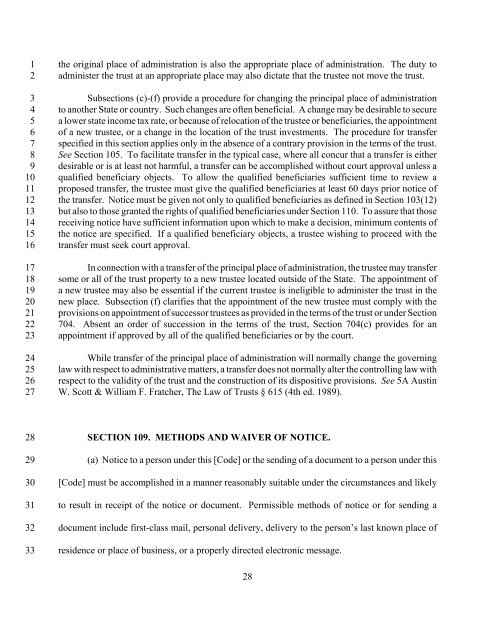uniform trust code - Kansas Judicial Branch
uniform trust code - Kansas Judicial Branch
uniform trust code - Kansas Judicial Branch
You also want an ePaper? Increase the reach of your titles
YUMPU automatically turns print PDFs into web optimized ePapers that Google loves.
1<br />
2<br />
3<br />
4<br />
5<br />
6<br />
7<br />
8<br />
9<br />
10<br />
11<br />
12<br />
13<br />
14<br />
15<br />
16<br />
17<br />
18<br />
19<br />
20<br />
21<br />
22<br />
23<br />
24<br />
25<br />
26<br />
27<br />
the original place of administration is also the appropriate place of administration. The duty to<br />
administer the <strong>trust</strong> at an appropriate place may also dictate that the <strong>trust</strong>ee not move the <strong>trust</strong>.<br />
Subsections (c)-(f) provide a procedure for changing the principal place of administration<br />
to another State or country. Such changes are often beneficial. A change may be desirable to secure<br />
a lower state income tax rate, or because of relocation of the <strong>trust</strong>ee or beneficiaries, the appointment<br />
of a new <strong>trust</strong>ee, or a change in the location of the <strong>trust</strong> investments. The procedure for transfer<br />
specified in this section applies only in the absence of a contrary provision in the terms of the <strong>trust</strong>.<br />
See Section 105. To facilitate transfer in the typical case, where all concur that a transfer is either<br />
desirable or is at least not harmful, a transfer can be accomplished without court approval unless a<br />
qualified beneficiary objects. To allow the qualified beneficiaries sufficient time to review a<br />
proposed transfer, the <strong>trust</strong>ee must give the qualified beneficiaries at least 60 days prior notice of<br />
the transfer. Notice must be given not only to qualified beneficiaries as defined in Section 103(12)<br />
but also to those granted the rights of qualified beneficiaries under Section 110. To assure that those<br />
receiving notice have sufficient information upon which to make a decision, minimum contents of<br />
the notice are specified. If a qualified beneficiary objects, a <strong>trust</strong>ee wishing to proceed with the<br />
transfer must seek court approval.<br />
In connection with a transfer of the principal place of administration, the <strong>trust</strong>ee may transfer<br />
some or all of the <strong>trust</strong> property to a new <strong>trust</strong>ee located outside of the State. The appointment of<br />
a new <strong>trust</strong>ee may also be essential if the current <strong>trust</strong>ee is ineligible to administer the <strong>trust</strong> in the<br />
new place. Subsection (f) clarifies that the appointment of the new <strong>trust</strong>ee must comply with the<br />
provisions on appointment of successor <strong>trust</strong>ees as provided in the terms of the <strong>trust</strong> or under Section<br />
704. Absent an order of succession in the terms of the <strong>trust</strong>, Section 704(c) provides for an<br />
appointment if approved by all of the qualified beneficiaries or by the court.<br />
While transfer of the principal place of administration will normally change the governing<br />
law with respect to administrative matters, a transfer does not normally alter the controlling law with<br />
respect to the validity of the <strong>trust</strong> and the construction of its dispositive provisions. See 5A Austin<br />
W. Scott & William F. Fratcher, The Law of Trusts § 615 (4th ed. 1989).<br />
28<br />
29<br />
30<br />
31<br />
32<br />
33<br />
SECTION 109. METHODS AND WAIVER OF NOTICE.<br />
(a) Notice to a person under this [Code] or the sending of a document to a person under this<br />
[Code] must be accomplished in a manner reasonably suitable under the circumstances and likely<br />
to result in receipt of the notice or document. Permissible methods of notice or for sending a<br />
document include first-class mail, personal delivery, delivery to the person’s last known place of<br />
residence or place of business, or a properly directed electronic message.<br />
28

















